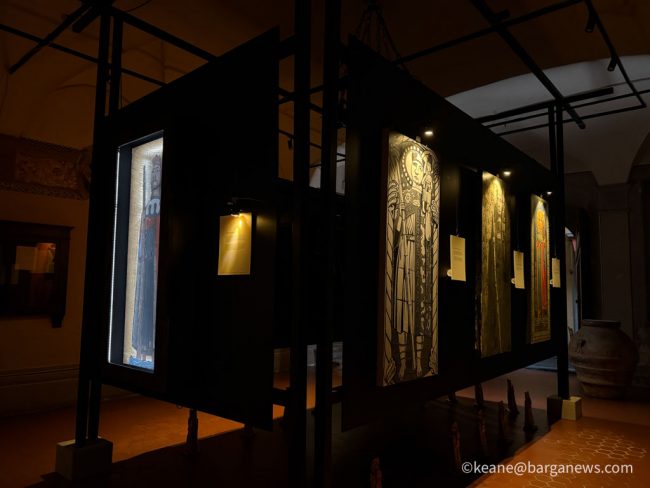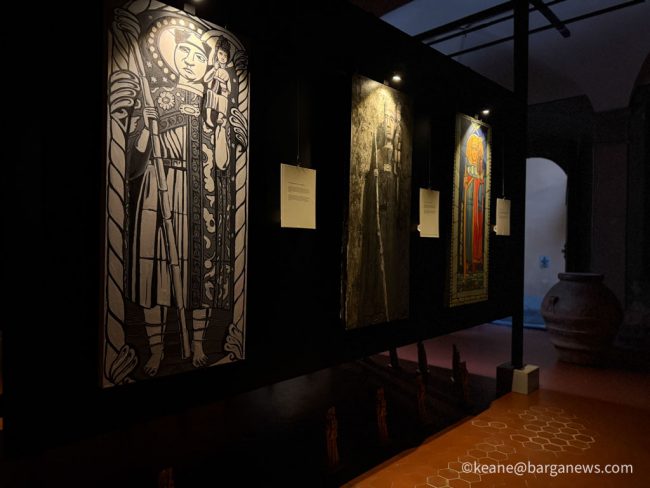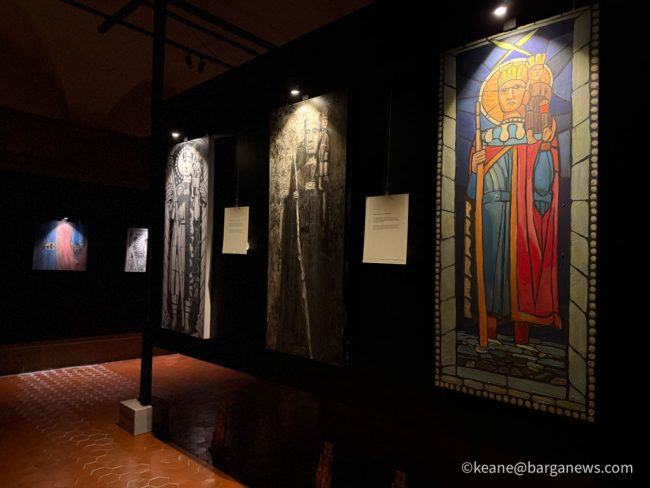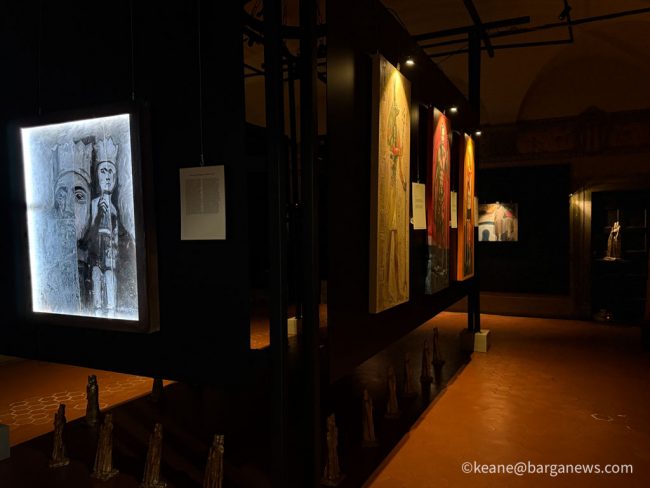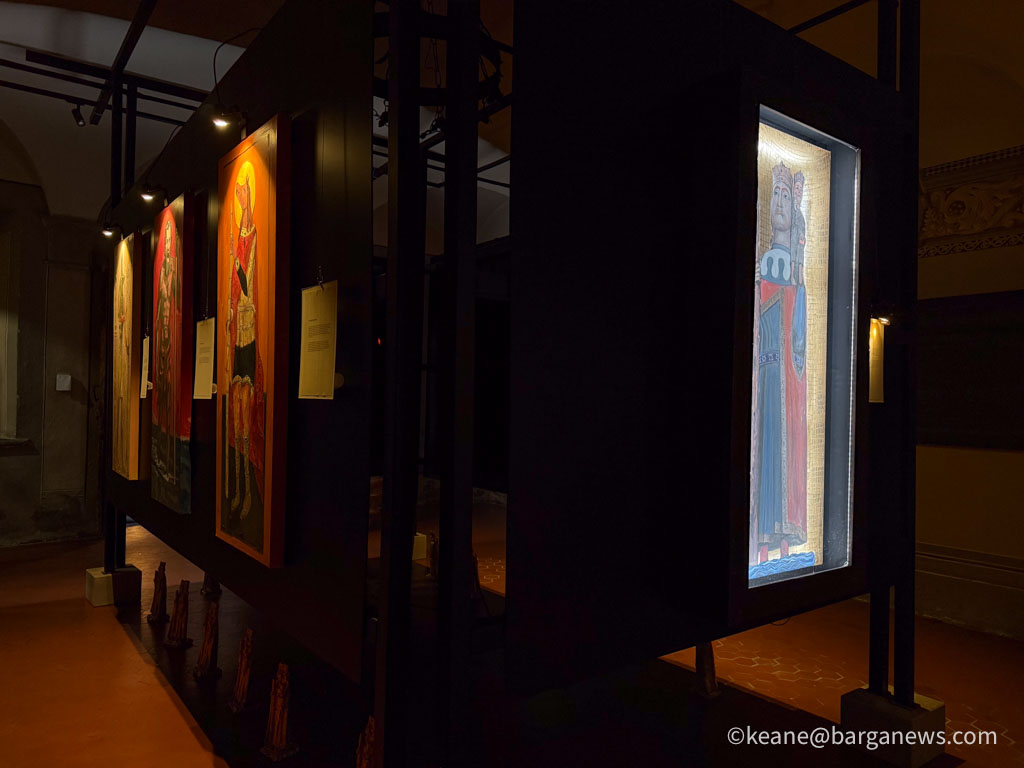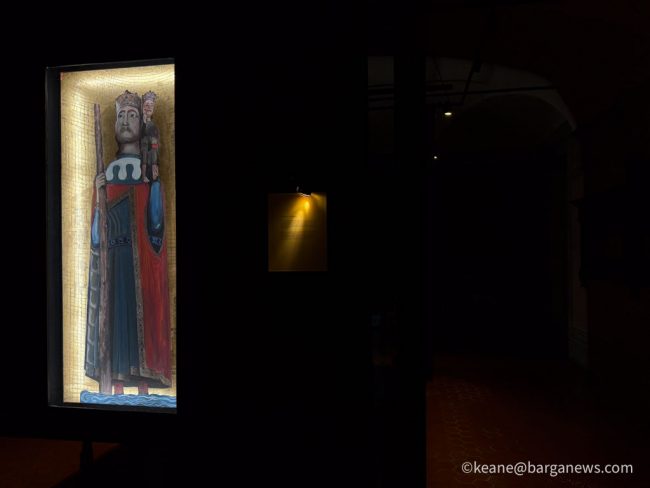San Cristoforo di Barga: – La Statua di Legno nella Luce e nel Tempo Paintings by Keane, Palazzo Pancrazi 9th August – 11th September 2025
This August marks the Barga artist Keane’s 40-year retrospective at Fondazione Ricci — and simultaneously at Palazzo Pancrazi, his return to the monumental centerpiece of Barga’s evocative landscape: The Duomo. Eleven years after his remarkable series of paintings exploring the enigmatic bas-reliefs on its upper facade, he has trained his painterly eye on the giant thousand-year-old wooden statue that commands its interior. The focal point of the Duomo’s long central nave is not a crucifix, as in almost all other Roman Catholic churches. It is that enormous wooden statue, nominally representing San Cristoforo, but closer in spirit to a forest deity of the Celto-Ligurian tribes who inhabited the Garfagnana before the arrival of Christianity.
The late Professor Stefano Borsi, a son of Barga who became one of Italy’s most eminent art historians, once commented that “walking into the Duomo is the closest we can come to experiencing the sensation of entering a pagan temple more than 2,000 years ago.” As though in moot testimony to that observation, the Vatican quietly removed San Cristoforo from its liturgical calendar in 1969, citing a lack of historical evidence documenting his life. Nonetheless he remains exceedingly popular with the faithful, usually depicted in the act of carrying the child Jesus on his shoulder across a raging river and venerated as the protector of travellers. Medieval Barga also regarded him as a military ally. When the statue was restored in the 1920s, scores of arrow heads were found buried in its flanks. Presumably it had been borne around the town’s ramparts to ward off assaulting armies, during four violent sieges between the mid-13th and 15th centuries, and peppered by enemy bowmen.
From his more familiar post behind the main altar, San Cristoforo gazes straight through the Duomo’s monumental doors toward the western horizon. When weather permits, the Apuan Alps’ dramatic sunsets bathe the statue in a beam of ethereal light that has held mystical significance for generations of Barghigiani.
Keane has outfitted one of his images with lighting software that strikingly replicates this luminous caress.
His full San Cristoforo cycle reaches far beyond the origins of Barga, however, to Pharaonic Egypt in the third millennium before the Christian era, drawing analogies between the Duomo statue and the jackal-headed Anubis, who guided the souls of the dead into the underworld. The exhibition moves on to the early epochs of Eastern Orthodox Christianity, which similarly pictured the saint as a cynocephalus (‘dog-headed creature’) who provided assistance to travellers. In other Keane variations, San Cristoforo appears in a Gothic stained glass window, a series of somber monocolor images in his iconic role fording a river with the Christ child on his shoulder — and a phalanx of gilt plaster figurines, facsimiles of those manufactured by the thousands in China for the religious tourist trade.
A nod to the ironies of global capitalism’s role in the confrontation between tradition and change in Barga, the artist’s recurrent theme over four decades. — Frank Viviano
9th August – 11th September Palazzo Pancrazi Barga Vecchia “San Cristoforo di Barga – La Statua di Legno nella Luce e nel Tempo” (Saint Christopher of Barga – The Wooden Statue in Light and Time) Exhibition of paintings by Keane based on the work of prof.STEFANO BORSI
San Cristoforo di Barga: – La Statua di Legno nella Luce e nel Tempo Dipinti di Keane, Palazzo Pancrazi 9 agosto – 11 settembre 2025
Questo agosto segna la retrospettiva dei 40 anni dell’artista barghigiano Keane alla Fondazione Ricci — e, contemporaneamente, a Palazzo Pancrazi, il suo ritorno al fulcro monumentale del paesaggio evocativo di Barga: il Duomo.
A undici anni dalla notevole serie di dipinti che indagava gli enigmatici bassorilievi della sua facciata superiore, Keane ha rivolto lo sguardo pittorico alla gigantesca statua di legno millenaria che ne domina l’interno. Il punto focale della lunga navata centrale del Duomo non è un crocifisso, come nella quasi totalità delle chiese cattoliche. È quell’enorme statua lignea, che nominalmente rappresenta San Cristoforo ma che, nello spirito, è più vicina a una divinità delle foreste delle tribù celto-liguri che abitarono la Garfagnana prima dell’arrivo del Cristianesimo.
Il compianto professor Stefano Borsi, barghigiano d’origine e tra i più eminenti storici dell’arte italiani, osservò una volta che «entrare nel Duomo è quanto di più vicino possiamo provare alla sensazione di entrare in un tempio pagano di oltre duemila anni fa». Quasi a testimonianza implicita di tale osservazione, nel 1969 il Vaticano rimosse discretamente San Cristoforo dal calendario liturgico, citando la mancanza di prove storiche sulla sua vita. Ciononostante, il santo rimane estremamente popolare tra i fedeli, di solito raffigurato nell’atto di portare il Bambino Gesù sulla spalla attraverso un fiume in piena e venerato come protettore dei viaggiatori.
La Barga medievale lo considerava anche un alleato militare. Quando la statua fu restaurata negli anni Venti, decine di punte di freccia vennero ritrovate conficcate nei suoi fianchi. Presumibilmente era stata portata lungo le mura cittadine per scongiurare gli eserciti assedianti — durante quattro violenti assedi tra la metà del XIII e il XV secolo — e bersagliata dagli arcieri nemici.
Dalla sua più consueta postazione dietro l’altare maggiore, San Cristoforo guarda dritto attraverso i portali monumentali del Duomo verso l’orizzonte occidentale. Quando il meteo lo consente, i tramonti spettacolari delle Alpi Apuane avvolgono la statua in un raggio di luce eterea che, per generazioni di barghigiani, ha avuto un significato quasi mistico.
Keane ha dotato una delle sue immagini di un software di illuminazione che replica in modo sorprendente questa carezza luminosa.
L’intero ciclo su San Cristoforo si spinge però ben oltre le origini di Barga, fino all’Egitto faraonico del terzo millennio avanti l’era cristiana, tracciando analogie tra la statua del Duomo e Anubi, dalla testa di sciacallo, che guidava le anime dei defunti nell’oltretomba. La mostra prosegue poi nelle prime epoche del cristianesimo ortodosso orientale, che parimenti raffigurò il santo come un cinocèfalo («creatura dalla testa di cane») che prestava aiuto ai viandanti.
In altre variazioni di Keane, San Cristoforo appare in una vetrata gotica, in una serie di immagini monocrome e austere nel suo ruolo iconico mentre guada un fiume con il Bambino sulle spalle — e in una falange di statuine dorate in gesso, facsimili di quelle prodotte a migliaia in Cina per il mercato del turismo religioso. Un cenno alle ironie del ruolo del capitalismo globale nel confronto tra tradizione e cambiamento a Barga, tema ricorrente dell’artista da quattro decenni. — Frank Viviano






